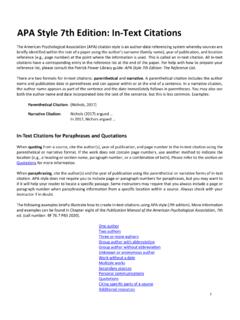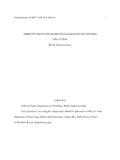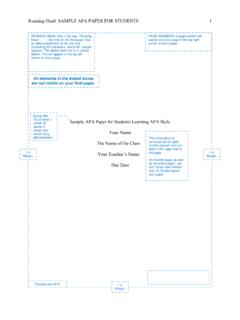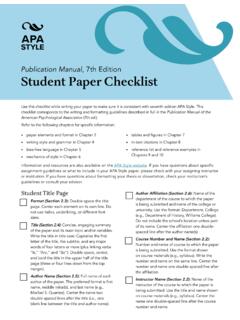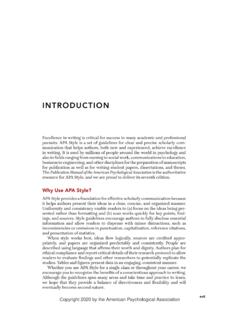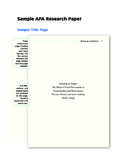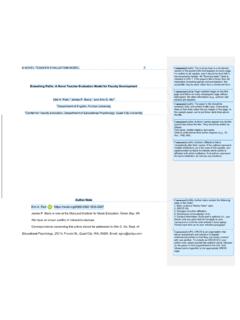Transcription of APA Style 7th Edition: The Reference List
1 APA Style 7th Edition: The Reference List This guide provides examples of how to cite sources using the American Psychological Association (APA) citation Style . In APA Style , a source is briefly cited within the text of a research paper using the author's surname (family name) and the date of publication. This is known as an in-text citation. A detailed list of all in-text citations is provided at the end of the research paper on a separate page with the word References (in bold) centered at the top of the page. Reference list entries are organized alphabetically by author, and by title for entries with no author.
2 All entries are double-spaced and have a hanging indent, meaning the second and subsequent lines of an entry are indented cm ( in) from the left margin. Reference list entries typically contain four elements: Author (individual(s) or group(s) responsible for the work being cited). Date of publication (or when the date is unknown). Title of the work Source where the work can be located Formatting of references will vary depending on the type of work you are citing. Sometimes the work you are trying to cite will be missing information such as the author or date, and you will need to modify your citation.
3 This guide contains examples of how to cite common types of works and information on how to adapt references when elements are missing or unknown. Within this guide, Reference examples are grouped into the following categories. Click on a category below to move to that section of the guide: Periodicals and Blogs Books, Book Chapters, Reference Works, and Book Reviews Reports, Conference Presentations, Dissertations and Theses, Preprints Data Sets Tests, Scales, and Inventories Audiovisual Media Social Media Webpages and Websites Personal Communications Additional Resources 1. Periodicals and Blogs General format for articles from periodicals ( , journals, magazines, newspapers, blogs): Author name(s).
4 (publication date). Title of article. Title of Periodical, volume number, (issue number), pages. DOI or URL. The format of the various parts of the Reference may vary depending on the type of periodical you are citing. When information in the source is missing or unknown ( , volume numbers, issue numbers, pages), omit them from the Reference . The following examples illustrate how to cite common types of periodicals. Please refer to the Publication Manual of the American Psychological Association, 7th ed., (pp. 316-321) for more information and examples. Journal article with a DOI: Roulin, N.
5 , & Krings, F. (2020). Faking to fit in: Applicants' response strategies to match organizational culture. Journal of Applied Psychology, 105(2), 130 145. DOIs and URLs: A DOI (Digital Object Identifier) provides a stable and persistent link to an article, book, or other document on the internet. Include a DOI for all works that have a DOI. The preferred format for a DOI is to display it as a hyperlink beginning with followed by the DOI. number as shown in the example above. All DOIs in your Reference list should be formatted this way. If a DOI in a work you are citing follows a different format, edit the DOI so that it reflects the preferred format.
6 Both DOIs and URLs can be displayed as plain text (no underlining) or with underlining ( , the default setting for hyperlinks in most word-processors). Both are acceptable, but choose one format and be consistent throughout your Reference list. Do not add a period at the end of a DOI/URL or manually insert a line break. Line breaks that are automatically inserted by your word-processor are acceptable. Journal article without a DOI, with a nondatabase URL: Woods, A. D., Taylor, M., & Dumas, B. (2019). Social media usage by millennial college students: The development of the digital-age student leader.
7 Academy of Educational Leadership Journal, 23(1), 1 7. For online articles that do not have a DOI, but do have a URL, include the URL in the Reference . URLs should link directly to the article when possible. For articles retrieved from academic research databases that do not have a DOI, refer to the next example. 2. Journal article without a DOI, from most academic research databases or print version: Jain, L., & Ansari, A. A. (2018). Effect of perception of organisational politics on employee engagement with personality traits as moderating factors. The South East Asian Journal of Management, 12(1), 85 104.
8 Do not include the database name or URL for most academic research databases. If an article does not contain a DOI, format the citation as if you were citing the print version of the article. Some exceptions may apply, for example, the database name is included in the Reference if the work you are citing can only be retrieved from that particular database. Please refer to Chapter 10, examples 13 & 14, p. 319 of the Publication Manual of the American Psychological Association, 7th ed. for more information. Journal article with a DOI, multiple authors: Curry, O. S., Rowland, L. A.
9 , Van Lissa, C. J., Zlotowitz, S., McAlaney, J., & Whitehouse, H. (2018). Happy to help? A systematic review and meta-analysis of the effects of performing acts of kindness on the well-being of the actor. Journal of Experimental Social Psychology, 76, 320 329. For articles with two to 20 authors, include all authors (surname followed by initials). Insert an ampersand (&). before the final author. For articles with 21 or more authors, include the first 19 authors, followed by an ellipsis (..), and then the final author (see Chapter 10, example 4, p. 317 of the Publication Manual of the American Psychological Association, 7th ed.)
10 Journal article with an article number or eLocator: Xie, Z., & Zhou, S. (2020). Bilingualism, demographics, and cognitive control: A within-group approach. Frontiers in Psychology, 11, Article 94. If an article has an article number or eLocator ( , e0206266), include it in the citation instead of page numbers. Precede the number with the word Article (capitalized). Magazine article with a DOI: Xu, L. (2018, November). Exploiting psychology and social behavior for game stickiness. Communications of the ACM, 61(11), 52 53. Magazine or newspaper article without a DOI, with a nondatabase URL: Gallo, A.
